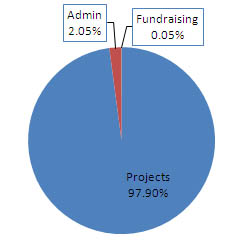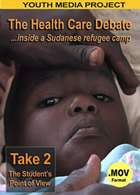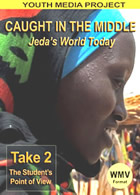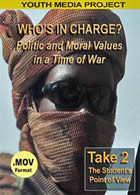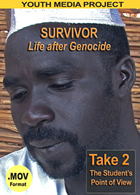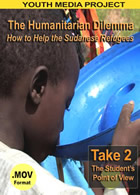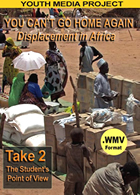A Red-Eared Donkey
I was in Chad, on the western border of Sudan, filming the Sudanese refugees who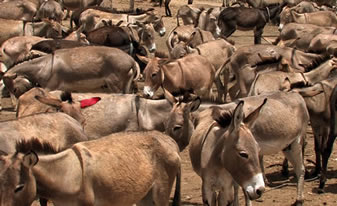 had fled their country in the wake of the Darfurian genocide. Over a hundred humanitarian organizations were there as well, and they had long since snatched up the few available vehicles in a country that has less than 30 miles of paved road. Hiring a pickup truck - even one held together with duct tape and baling wire - was far beyond my means. So I rented a donkey.
had fled their country in the wake of the Darfurian genocide. Over a hundred humanitarian organizations were there as well, and they had long since snatched up the few available vehicles in a country that has less than 30 miles of paved road. Hiring a pickup truck - even one held together with duct tape and baling wire - was far beyond my means. So I rented a donkey.
.
I called him "Jumar". He was gray with a black stripe across his shoulders - just like every other donkey in North Africa. And since he didn't even look up when called, I couldn't pick him out of a lineup if my life depended on it. The Sudanese were completely baffled by this, as though I couldn't recognize my own dog at the park.
Most mornings I'd ride Jumar out through the ankle-deep sand to the local refugee camps. Once there, I'd tie him to a tree in the donkey parking lot, wrap a ribbon around the tree trunk, and head off to work. The moment I was gone, the local kids would scamper out, untie Jumar, and tie him to a different tree. I'd come back several hours later, exhausted from trudging around in the 100+ degree heat, and start wandering tree to tree, muttering "Jumar?" into each donkey's ear. The kids thought this was hilarious. I did not. One day, thoroughly sick of the game, I borrowed a dry-erase marker and colored Jumar's left ear red. This worked very well until it rained and Jumar's entire face turned pink. His owner thought I had given him some weird Western disease and had a meltdown.
But my real goal wasn't just to film the refugee camps and marketplaces. I wanted to get into a local village and show what life had been like before the genocide. The humanitarian workers told me this was impossible - that I would never get permission from the government. I finally rode out to the airless compound where the local bureaucrats hung out, handed my petition to a listless assistant, and sat down on a broken chair to wait. Eventually a well-dressed man sitting at the large scuffed desk at the front of the room shuffled indifferently through my stack of paperwork, a permanent look of disdain etched into his face. Halfway through he dropped my papers and looked to the next petitioner. Just then another assistant came in and muttered something into his ear. The bureaucrat looked at me sharply and a brief, whispered conversation took place. He crooked a finger at me, and I approached, wondering if I was about to go to jail.
"You are the white girl with the donkey?" he asked sternly. There was no point in denying it - Jumar  was tied up less than twenty feet away. The man stared at me for a moment, then the mask of disdain dissolved into a smile, then a full-bellied laugh. He shook his head a couple of times in disbelief, shuffled to the end of my pile of papers and stamped them with a resounding thwack. When I left he was still chuckling.
was tied up less than twenty feet away. The man stared at me for a moment, then the mask of disdain dissolved into a smile, then a full-bellied laugh. He shook his head a couple of times in disbelief, shuffled to the end of my pile of papers and stamped them with a resounding thwack. When I left he was still chuckling.
The Bucket List
Maureen Fagan is a science teacher who asked to use our footage for her class project on global water resources. She also sent us - unsolicited - a comprehensive set of lesson plans she'd developed. I shipped off the footage immediately.
The school year was almost over when I got an email from her that would 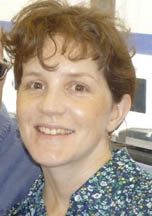 change my life. We were at the time struggling with some fundamental decisions about how to define our curriculum - should we provide materials that encouraged only the highest levels of critical thinking and analysis, or would teachers want more traditional fill-in-the-blank teaching tools and activities?
change my life. We were at the time struggling with some fundamental decisions about how to define our curriculum - should we provide materials that encouraged only the highest levels of critical thinking and analysis, or would teachers want more traditional fill-in-the-blank teaching tools and activities?
Maureen's email explained that, though her students were sympathetic to the lives of the Sudanese refugees they saw in our footage, she didn't think they truly understood what those lives were like. So she kidnapped a bucket from the school sport shed, filled it with five gallons of water, and had each student carry it around the school yard a couple of times. Five gallons- that's just over forty pounds. The exercise only took half an hour, but it rocked their world. The next time those students looked at the footage and saw an eight-year-old girl walking two miles to her hut with a bucket on her head, they empathized.
We immediately put a new activity into our curriculum. We called it The Bucket List and added a couple more suggestions along the same lines. I knew at that moment what we were all about, and that it was teachers like Maureen and their simple, sophisticated ideas that we needed to celebrate and spread.
I'll bet Maureen's students never forget that warm, sunny day in a Connecticut schoolyard and the lesson they learned from a cheap plastic bucket and a remarkably creative teacher. Neither will I.
The Dream
It all started with an argument. A bunch of us were sitting around the National Geographic studios after a long day, and the field producers started insisting that the best way to learn about a culture was to take a camera into the field and film it. The editors, not surprisingly, were convinced that you really only developed understanding and empathy for people when you had to put yourself in their shoes during the editing process in order to tell their story.
I had done both, and although I loved the excitement and challenge of the field, I tended to agree with the editors. It was at that moment that I realized we could teach global citizenship to students by letting them edit our professional footage into their own documentaries - in effect, by giving them the chance to tell the stories of gobal issues and people themselves.
National Geographic didn't go for it but four years later, with the help of a half dozen expert volunteers, 62 (exhausted) pilot teachers and fifteen hundred students, my retirement savings, and several dozen loyal supporters and friends, six modules of footage/curriculum are ready for high school and university students throughout the USA and across the globe.
Students helped bring down apartheid in South Africa by demanding corporate divestment. If we can teach today's youth that they have the ability to create change, then they will have a powerful and positive force within our society and throughout the world.
The future is in good hands.
"Your footage is breathtaking! I am blown away every time I look at a new sequence. Your work will take us to a new level over here." Teacher, NYC

